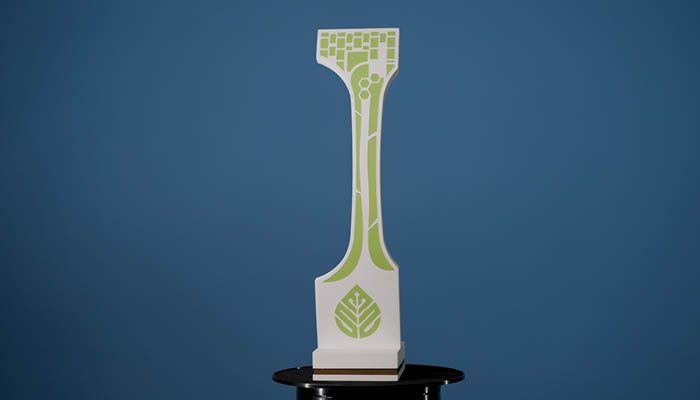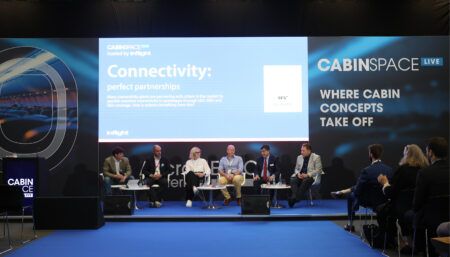The shortlist has been drawn up for the 2024 Crystal Cabin Awards, with the winners to be revealed on 28 May 2024 in Hamburg, Germany, as part of Aircraft Interiors Expo. The awards, organised annually by Hamburg Aviation, recognise aircraft cabin innovations across eight categories.
The categories are Cabin Concepts, Cabin Systems, Health & Safety, IFEC & Digital Services, Material & Components, Passenger Comfort, Sustainable Cabin, and University.
There are 72 entries on the 2024 shortlist. An international jury of 28 experts will select three finalists for each category, who will be announced in April 2024. All finalists will present their ideas to the jury at Aircraft Interiors Expo (28-30 May 2024). The winners will be announced on the evening of 28 May at a gala dinner at the Hamburg Chamber of Commerce. This year there are two new members on the jury: Jörg Rissiek, senior vice president of sales, marketing and business development at Diehl Aviation; and Claudia Friedrich, managing director of interface design at zweigrad Industrial Design.
The list of nominees reflects a wide range of innovations, from seating concepts to cabin materials and entertainment systems.
Comfort
One of the themes to emerge in the shortlist is comfort in economy class. For example, Ameco’s FlyBuddy Hub is a social seating concept in which six passengers can sit opposite each other. The modular design creates a versatile space with convertible seats and beds, folding tables, a roll-up screen and intelligent partitions.
Qantas Airways is due to begin offering non-stop ‘Sunrise’ flights from Sydney and Melbourne to London and New York by the end of 2025. Diehl Aviation has designed a Wellbeing Zone for the A350 to support comfort on these long-haul flights. The Wellbeing Zone, accessible to travellers of all classes, offers space for a guided training programme on screens, a drinking station and a range of healthy snacks.
Meanwhile, for premium economy, the Zephyr seat from Zephyr Aerospace is designed to deliver privacy and the option to sleep lying down. The flat aircraft seat is intended for long-haul flights in this class with direct access to the aisle and complete privacy for every traveller. The stacked design of the seat in intended to enable any Zephyr seat to be installed without loss of seat density.
The cabin interior of Japan Airlines’ new A350-1000 – for which the airline collaborated with Tangerine, Safran Seats and Recaro Aircraft Seating – encompasses four classes: first, business, premium economy and economy. Completely redesigned seats with the elegance of Japanese aesthetics can be found in all classes. In business and first, travellers can enjoy a headphone-free IFE system with loudspeakers in the seat. In first, there is a dining area for three people and a seat that can be converted into an extra-wide bed. In premium economy, passengers will find automatic electric seat adjustment and a fixed partition between the seats in the middle of the cabin to maximise privacy.
Accessibility
When it comes to concepts for accessible travel, the main focus of this year’s submissions is on assistive auditory, visual, cognitive and motor functions that can make air travel accessible and enjoyable for as many passengers as possible. For example, the Wheelchair Space and Securement System (WSSS) from the University of Virginia Tech in cooperation with Boeing, All Wheels Up and Collins Aerospace, benefits passengers with limited mobility by integrating the space required to secure wheelchairs into adaptable economy seats.
Meanwhile Collins Aerospace’s ADAPT digital flight experience control follows the philosophy of inclusive design by allowing passengers to connect their mobile phone to their seat. The passenger’s device communicates with all active visual sensors such as seat controls, IFE controls and the crew. It even enables voice recognition or American Sign Language (ASL) recognition.
The ACCESS Beam from Airbus is a solution for the temporary conversion of the aircraft cabin during ground turnaround for the transport of wheelchairs. It is designed to offer airlines maximum flexibility and passengers in wheelchairs the safety and comfort of flying in their own wheelchair.
Safran Passenger Innovations (SPI), in cooperation with Air New Zealand and Virgin Atlantic, has designed a product to enable passengers with auditory, visual, cognitive and motor impairments to enjoy the IFE.
M-SAAVE is an interdisciplinary student project team at the University of Michigan dedicated to humanitarian applications of aerospace engineering. Under the leadership of Collins Aerospace, it has developed a safety system for passengers with reduced mobility. This allows passengers to remain seated in their own wheelchair for the duration of a commercial flight.
Sustainability
Several entrants in the 2024 season are focused on offering significant weight (and therefore emissions) savings, among others, companies like Zotefoams, Collins Aerospace, Diehl Aviation, Safran Cabin and a consortium headed by Hamburg-based Comprisetec. These companies are using a diverse range of approaches to lowering weight, including ultra-lightweight foam insulators; manufacturing techniques that use far less material; new resin-based interior panels; ceiling seat anchor points that replace overhead bins; and water dispensers that replace bottled water on board.
The reuse and recycling of materials is also a focus. Airbus’ C-Suite Circular Business Class, for example, is built around a commitment to use far more recycled materials in its business-class seats than previous offerings.
Seat manufacturer Recaro makes a similar pledge with its R Sphere concept that prioritises used and upcycled materials.
Gen Phoenix, in cooperation Sabeti Wain Aerospace and Doy Design, has entered a seat dress made using a special 100% recycled fabric intended to be much easier to recycle than similar materials.
Meanwhile Aircraft Cabin Modification’s TexEco material is a 100% natural fibre certified for aircraft cabins.





